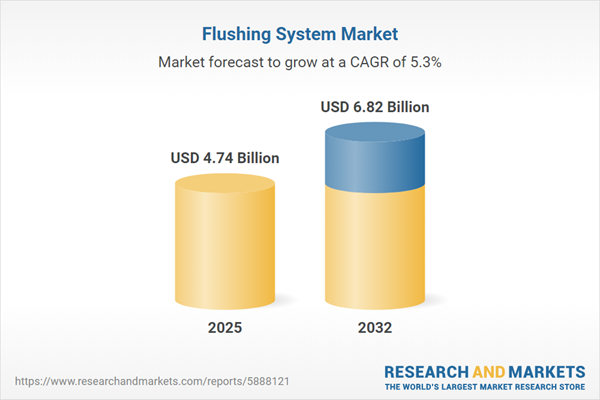Speak directly to the analyst to clarify any post sales queries you may have.
The global flushing system market is evolving as leaders drive a shift toward sustainable, compliant, and resilient building solutions. Strategic priorities center on future-ready infrastructure that upholds operational excellence while addressing both regulatory and environmental mandates.
Market Snapshot: Flushing System Market Size and Outlook
The flushing system market is valued at USD 4.50 billion in 2024, with steady growth projected to USD 4.74 billion in 2025, resulting in a compound annual growth rate of 5.31%. Looking ahead to 2032, the market is expected to exceed USD 6.82 billion. This positive trajectory is fueled by global water efficiency mandates, strengthened compliance standards, and rising adoption across residential, commercial, and institutional buildings. Technological advancement and rapid modernization of aging infrastructure support opportunities in both new project installations and system retrofits. Facility owners and managers are increasingly adopting innovative solutions to respond effectively to shifting regulations and evolving operational needs across diverse property portfolios.
Scope & Segmentation of the Flushing System Market
- System Types: The market includes dual flush, gravity flush, pressure-assisted, and vacuum flush solutions, with each addressing specific requirements for water use reduction, efficiency, and performance in both renovation and new construction projects.
- End Users: Key stakeholders comprise commercial real estate firms, industrial facilities, multi-family housing developers, and single-family property owners, each group prioritizing configurations that meet compliance, reliability, and efficiency expectations.
- Distribution Channels: Products are distributed through traditional retail, wholesale sanitary ware, systems integrators, and digital procurement platforms. These diverse channels connect contractors and maintenance operators to emerging solutions swiftly and effectively.
- Material Types: The market features plastic, stainless steel, and vitreous china options, allowing decision-makers to align materials with project requirements for durability, cost efficiency, hygiene, and corporate sustainability objectives.
- Technology Adoption: Both manual and sensor-activated units are prominent, with a rising emphasis on network-integrated solutions that answer the demand for advanced hygiene, usage monitoring, and enhanced efficiency, especially in regulated or high-traffic settings.
- Geographical Regions: Distinct investment strategies and technology choices are shaped by the differing regulatory, infrastructure, and development contexts found in North America, Europe, Asia-Pacific, the Middle East, and Africa.
- Key Industry Participants: Leading organizations such as LIXIL Corporation, TOTO Ltd., Kohler Co., Roca Sanitario S.A., Geberit AG, Rexnord Corporation, Fluidmaster Inc., Duravit Aktiengesellschaft, Villeroy & Boch AG, and Sloan Valve Company influence industry evolution and adapt rapidly to new requirements and expectations.
Key Takeaways: Navigating Flushing System Market Evolution
- Sensor-enabled and digitally integrated units are enabling enhanced hygiene protocols and supporting seamless maintenance oversight, especially valuable in environments with frequent usage or heightened regulatory attention.
- Ongoing collaboration among manufacturers and regulators is facilitating modular retrofit options, making compliance with evolving legal and sustainability requirements more accessible while keeping facilities current.
- There is a transition toward increased use of recycled and composite materials, reducing supply chain uncertainty and furthering environmental responsibility for essential facility projects.
- Integration with digital building management systems delivers operational transparency and enables comprehensive tracking of performance and lifecycle metrics for property managers.
- Manufacturers are customizing solutions to reflect the diversity in regional codes and infrastructure, helping organizations maintain compliance and deliver reliable performance throughout varied global markets.
Tariff Impact: Navigating Cost and Supply Chain Challenges
Recent tariffs on plastics and metals within the United States are compelling manufacturers to adapt their sourcing approaches. Many are now evaluating the benefits of regionalizing suppliers and exploring alternative material use. These adjustments help counteract trade disruptions, optimize costs, and promote greater supply chain resilience in the face of ongoing economic shifts.
Methodology & Data Sources
This analysis draws on detailed desk research and insights from interviews with high-level executives and technical experts. Regional case studies and segment-specific examples ensure practical recommendations tailored for a wide range of strategic end users.
Why This Report Matters
- Enables leaders to benchmark technology adoption and segment developments, ensuring that decisions are informed and data driven.
- Supports robust procurement processes and supply chain strategies while elevating sustainability and compliance across international and regional portfolios.
- Provides management teams with actionable insights to secure growth opportunities and manage compliance and operational risks amid industry shifts.
Conclusion
Adapting to regulatory developments and adopting future-ready technologies strengthens organizational resilience. Forward-thinking strategies and agile supply chains underpin ongoing success as industry and compliance standards continue to progress.
Additional Product Information:
- Purchase of this report includes 1 year online access with quarterly updates.
- This report can be updated on request. Please contact our Customer Experience team using the Ask a Question widget on our website.
Table of Contents
3. Executive Summary
4. Market Overview
7. Cumulative Impact of Artificial Intelligence 2025
Companies Mentioned
The companies profiled in this Flushing System market report include:- LIXIL Corporation
- TOTO Ltd.
- Kohler Co.
- Roca Sanitario, S.A.
- Geberit AG
- Rexnord Corporation
- Fluidmaster, Inc.
- Duravit Aktiengesellschaft
- Villeroy & Boch AG
- Sloan Valve Company
Table Information
| Report Attribute | Details |
|---|---|
| No. of Pages | 198 |
| Published | October 2025 |
| Forecast Period | 2025 - 2032 |
| Estimated Market Value ( USD | $ 4.74 Billion |
| Forecasted Market Value ( USD | $ 6.82 Billion |
| Compound Annual Growth Rate | 5.3% |
| Regions Covered | Global |
| No. of Companies Mentioned | 11 |









